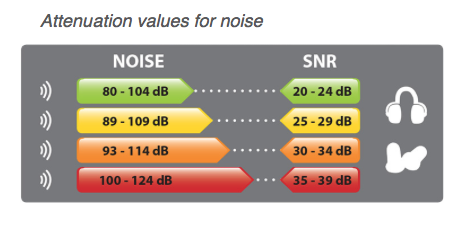How to choose the right hearing protection
A need for hearing protection is a common outcome of a noise assessment or a noise survey. Although it is technically at the bottom of the ‘hierarchy of controls’ whereby companies need to eliminate noise risk first, then control it by some other organisational means if possible, often hearing protection is either the only practical outcome or is needed as a temporary interim measure.
Hearing protection needs to be ‘just right’, so not too weak meaning people are still at risk, but also not too strong so people become isolated.
Key point: Never choose hearing protection on the basis that ‘stronger is better’.
Problems with over-protection
Over-protection means hearing protection which is reducing the noise by too much. It doesn’t sound like an issue on the surface of it but it can actually lead to an increase in noise risk for people, not a decrease.
When hearing protection is too powerful people start to feel isolated. When that happens they generally begin to wear the hearing protection incorrectly, so with plugs then don’t put them in very far, or with ear muffs (ear defenders) they sit them slightly off-centre on their ears to allow more noise through. Or they simply don’t wear them at all. In all cases they will now be exposed to harmful noise which the hearing protection is supposed to be guarding against.
As an additional risk, when hearing protection is too strong they can start to have problems hearing things like moving vehicles such as forklift trucks or vans in a yard, or start to be unable to hearing warning alarms or shouted warnings.
Remember, the employer has not met all their legal obligations by issuing hearing protection to people and telling them when and where to wear it, they also have an obligation to ensure the hearing protection is suitable (so not too strong) and also to monitor and enforce its use.
Link: HSE’s stance that hearing protection should not reduce noise levels below 70 dB(A).
How to check hearing protection is suitable for the noise risk
There is a nice simple way to do this. All hearing protection has an SNR figure, the Single Number Rating, which is the number of decibels it reduces the noise levels by.
(As an aside, our American brethren use NRR, not SNR and the two are not the same - you cannot used NRR here in the UK, if you see anything saying NRR, ignore it).
All you need to do is take the average dB(C) noise level which your noise assessment should give you, and subtract the hearing protector’s SNR from it. Then, add 4 back to it to allow for some slightly incorrect use, and the answer is the sound level people should be experiencing under the hearing protection. As an example:
· A Laser Lite plug has an SNR of 35. (And appalling spelling).
· The dB(C) result in the noise assessment for the job in question is 95 dB(C).
· The calculation is 95-35, giving 60dB
· Add 4dB to account for real-world usage so we get a result of 64dB, that’s what people experience.
By the way, do not use the peak dB(C) figure as that almost always comes out as the hearing protection being insufficient, you want the average dB(C) level. A noise assessment done by a good professional should have given you that figure. If you don’t have it you could use the average dB(A) figure but that is generating room for error and is best avoided as dB(A) and dB(C) are often not the same.
What is a good level under the protector
There is some guidance on this from the HSE and based on what they say, a good level under the protector is 70 to 80dB.
Personally, I think 80dB is getting too close to the limits so would always say 70 to 78dB.
65 to 69dB is not horrendous and that’s about the noise level of an office so not too quiet, but avoid anything below that.
As another rough guide:




